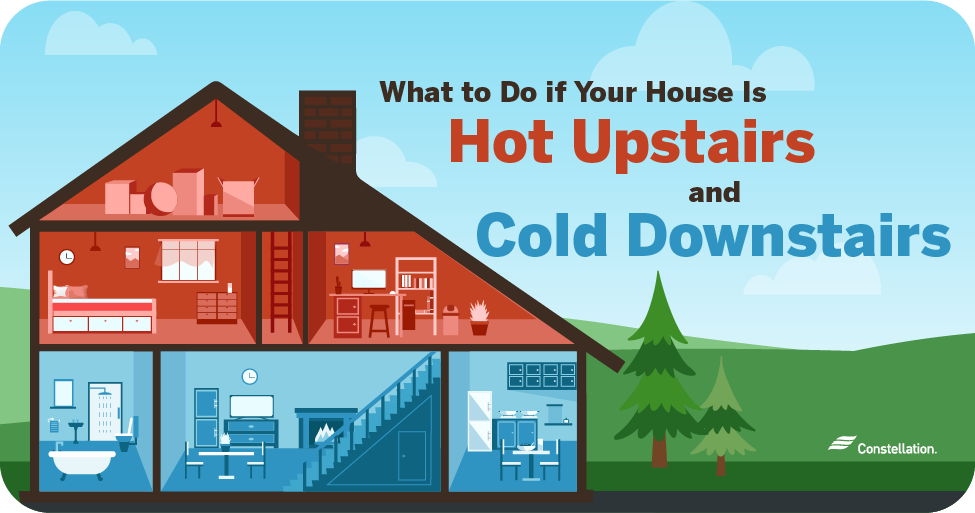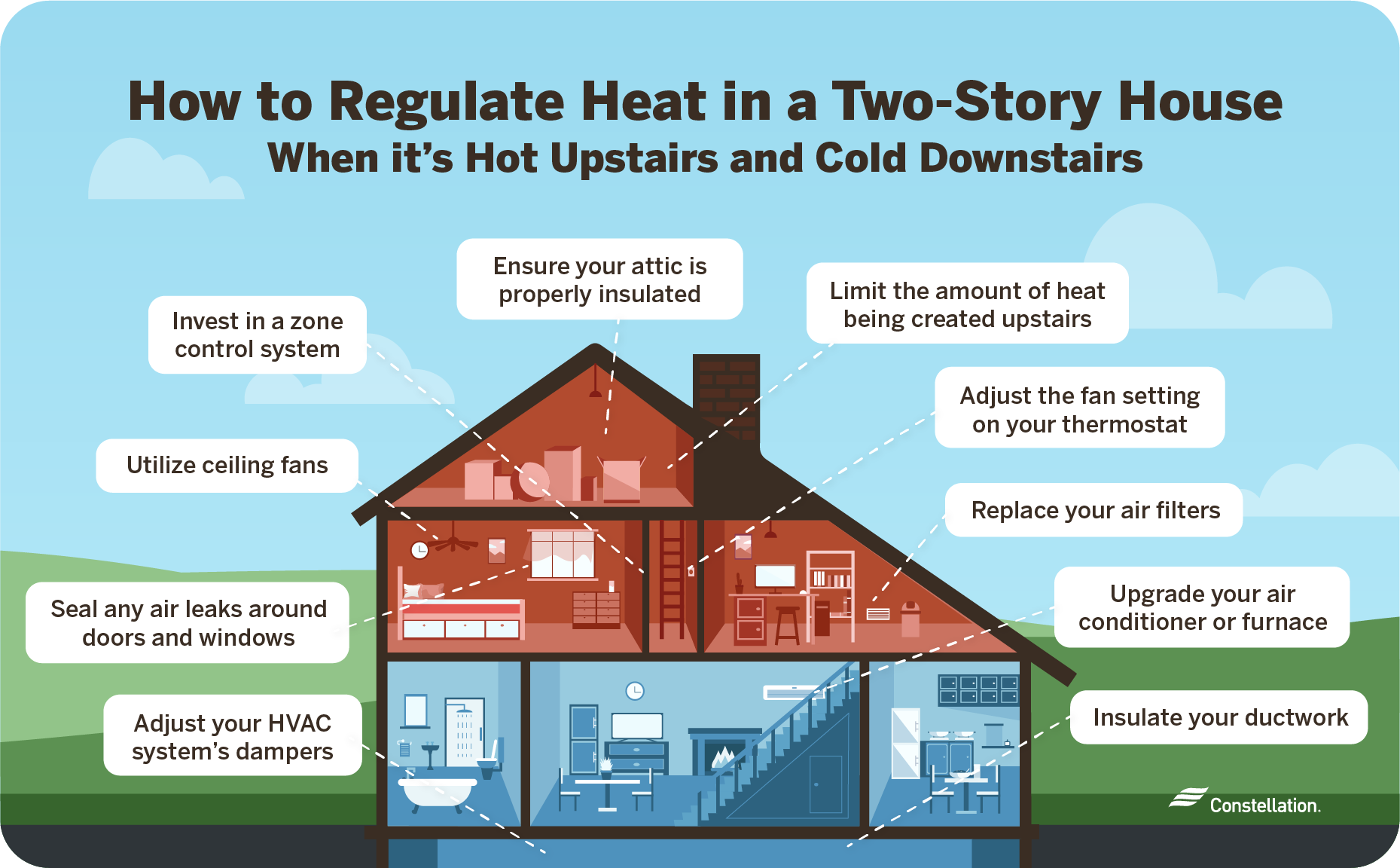
- Category:
Energy Efficiency -
Last updated:
June 20, 2022
What to Do if Your House Is Hot Upstairs and Cold Downstairs
Have you ever wondered why your house is hot upstairs and cold downstairs? One reason is because hot air rises and cold air sinks, so it’s natural that your upstairs rooms are warmer than the ones downstairs.
But there can be other causes beyond straight physics as to why upstairs is hotter than downstairs in your home. You might not have enough insulation, or you could have problems in how your system moves heat from upstairs to downstairs. Your single-zone HVAC might not be the best when it comes to how to regulate heat in a two-story house.
Here are some tips for ensuring every room is comfortable and that can help make heating and cooling your home more efficient in every season.
How to regulate heat in a two-story house
Regulating heat in a two-story house is important for energy efficiency. When the temperature in every area is well regulated, you may be more comfortable and possibly use less energy. It could also help solve the problem of your house being hot upstairs and cold downstairs.

1. Replace your air filters
When your HVAC system is running smoothly, it can be easier to regulate the temperature in your home and potentially prevent a hot upstairs and cold downstairs. One of the easiest and least expensive maintenance tasks you can perform every season is replacing your system’s air filters. You will be contributing to optimizing how well your HVAC system works.
2. Insulate your ductwork
Right along with a smooth-running HVAC system are ducts that efficiently deliver heat to every room. Even a little bit of dust and debris in ducts can slow down air flow. That is why cleaning air ducts is so important. But don’t stop there. Check to see that they are in good repair and fix any leaks. You may also want to add insulation to ducts in some areas.
Well-insulated ducts ensure that warm air stays warm on the journey from your furnace to the rooms in your home. Perhaps in the furnace vs. boiler debate, you opted to heat your home by hot water or steam. The same principles apply. You will want to make sure all the pipes are in good working order. Again, insulation may boost efficiency.
3. Invest in a zone control system
You can retrofit zone controls onto your existing HVAC system to control temperatures in each part of your house. You can turn down the heat on the second floor if your upstairs is hotter than downstairs. A zone control panel regulates the flow of heat in winter and cool air in summer. It receives information from thermostats that are installed in each zone in your home. It controls the flow of heat or cool air through dampers installed in your ductwork that can be opened or closed according to the temperature range you set.
4. Upgrade your air conditioner or furnace
It’s possible that your current HVAC system is no longer up to the job. New energy-efficient air conditioners and furnaces can help you achieve a consistent temperature throughout your home and work using much less energy than older models. Make sure that your system is sized for your home. You can save a little with smaller systems, but they may have to work harder, potentially costing more money in the long run.
5. Adjust your HVAC system’s dampers
Adjusting dampers is one way to help regulate heat in a two-story house. If your HVAC system is already set up with zones, take the time to locate and adjust the dampers so that less heat is going to the second floor and more is going to the first. Most dampers are located within a few feet of the main duct trunk that radiates off your furnace. To close them, push the lever down or turn the knob counterclockwise, depending on the style of damper you have. Managing your dampers will help with how to keep heat downstairs in winter.
6. Ensure your attic is properly insulated
Make sure you have adequate attic insulation and ventilation. It will help keep warm air in during the winter and cool air in during the summer. If you can heat and cool your attic more efficiently, you’ll enjoy more comfortable temperatures throughout your house. Energy-efficient fans in your attic can vent out and move air for even comfort on all your floors.
7. Seal any air leaks around doors and windows
One reason why you might find your upstairs hotter than downstairs is because you may have drafts that let in cold air on your first floor. Find air leaks in your home and invest some time and effort into door sealing and weatherstripping. Don’t forget to check for drafts around windows and any place where cold air or heat might enter your home. Seal up any place where air can seep in.
8. Utilize ceiling fans
Beyond fans in the attic, consider adding ceiling fans that can circulate the air in rooms around your house. They bring hot air down from the ceiling or raise cool air up from the floor. Well-placed fans can also help move heat from upstairs to downstairs. In the summer, they can circulate cooler air from your first floor up through to your second floor.
9. Adjust the fan setting on your thermostat
In addition to attic and ceiling fans, don’t neglect the fans in your HVAC system controlled by your thermostat. After you have determined your best thermostat settings, the fans ensure that air circulates efficiently through your ducts. They can also be a big help with keeping heat downstairs in winter. A smart thermostat lets you fine tune temperature and fan settings throughout the day and through all zones.
10. Limit the amount of heat being created upstairs
You might be making the situation worse when upstairs is hotter than downstairs if you are creating heat in those areas. Replace incandescent bulbs. Some 90 percent of the energy they consume is emitted as heat, not light, which adds warmth to already-hot rooms.
Other devices, from computers to hair dryers, also emit hot air. If you can use them downstairs, it will help reduce heat upstairs. Lastly, install blinds over upstairs windows and keep them closed when the sun is shining to reduce the solar heat coming into the house.
While the science of heat transfer makes it natural to have a hot upstairs and cold downstairs, a bit of effort and well thought out systems can help keep temperatures even in your house. In addition to experiencing better comfort, you may also have a much more energy-efficient HVAC system.




